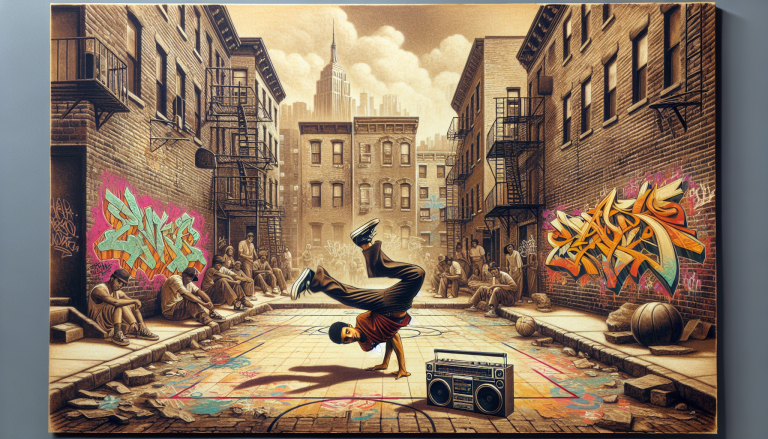The Birth of a Cultural Revolution: Hip-Hop’s Historical Context
Picture this: It’s the early 1970s in the South Bronx, New York City—a place pulsing with tension, creativity, and raw energy. Walls were crumbling, schools struggling, and streets alive with the hustle and bustle of survival. Out of this gritty yet vibrant urban chaos, a new sound emerged, rooted in African-American and Latino communities. This was hip-hop—more than just music; it was a cultural movement, a response to social conditions, and a method of storytelling that captured life’s grind and glory. Hip-hop’s birth wasn’t in a sleek studio but in public parks, community centers, and block parties, where DJs like Kool Herc began isolating breaks in funk and soul records and layering beats, crafting a soundscape that called people to dance, rhyme, and unite.
The socio-political landscape heavily influenced hip-hop’s development. Economic disparity, racial injustice, and disenfranchisement fueled artists to articulate their truths. Hip-hop became a megaphone for the voiceless, a platform for systemic critique wrapped in rhythmic poetry. This was not just American music; it was an urban soundtrack of resilience and revolution.
What Defines Hip-Hop? A Genre That’s Much More Than Music
If you think hip-hop is just rap, you’re only hearing half the story. Hip-hop is a cultural symphony consisting of four foundational pillars: DJing, MCing (rapping), breakdancing, and graffiti art. It’s the beat-driven heartbeat of street culture, where each element complements the others. The genre itself is characterized by rhythmic vocal delivery (rapping), often over looped beats sampled from funk, jazz, and soul records, blended with turntable scratching and powerful basslines that compel your body into motion.

Hip-hop’s sound is highly adaptive and eclectic. Early hip-hop drew from James Brown’s relentless grooves and the syncopated drum breaks of the Funk Brothers. But today, it’s a sprawling galaxy of styles—East Coast’s lyricism, West Coast’s laid-back funk, Southern trap’s booming 808s, and beyond. The genre’s narrative focus highlights storytelling with a personal, political, or poetic punch. It’s an art form that transforms street tales, cultural pride, and social commentary into an infectious rhythm that has captivated global audiences.
The Architects of Hip-Hop: Key Artists Who Built the Legacy
No history of hip-hop can ignore the pioneers who owned the decks, mic, and streets. DJ Kool Herc, often declared the “Father of Hip-Hop,” ignited the scene with his extended breakbeats at Bronx block parties. His innovative style became the blueprint for DJing and MCing. Grandmaster Flash took the science of turntablism further, inventing techniques like backspinning and punch phrasing that forever changed DJ culture. Their work wasn’t merely about music; it was performance art and community cohesion.
Then came the poetic voices—Grandmaster Melle Mel and The Furious Five, who gave us politically charged anthems like “The Message,” a piercing commentary on urban despair that showed hip-hop’s potential as social activism wrapped in rhythm. The 1980s and ’90s saw the rise of trailblazers like Run-D.M.C., who infused rock elements, and Public Enemy, with their militant stance and hard-hitting production. Meanwhile, artists like Tupac Shakur and The Notorious B.I.G. elevated hip-hop to cinematic storytelling, exploring themes of struggle, fame, and identity.
Hip-hop’s evolution also owes to influential producers like Dr. Dre—whose signature West Coast G-funk melded funk grooves with crisp synths—and innovators such as DJ Premier, whose jazzy samples defined East Coast boom-bap. These artists built a sonic empire and paved a path from underground movement to mainstream dominance.
Tracks That Moved the World: Notable Songs and Albums
There’s no shortage of hip-hop classics that shaped the genre’s sound and soul. “Rapper’s Delight” by The Sugarhill Gang might not have been the first rap record, but it’s the one that blasted hip-hop out of the underground and into the public earwaves in 1979. Then, “The Message” by Grandmaster Flash & The Furious Five (1982) offered a gritty narrative on systemic neglect, transforming hip-hop into a voice for lived realities.
Run-D.M.C.’s “Raising Hell” album (1986), featuring the genre-crossing “Walk This Way” with Aerosmith, marked hip-hop’s undeniable crossover charm. Public Enemy’s “It Takes a Nation of Millions to Hold Us Back” (1988) flipped the script with politically charged lyricism and bombastic production.
Fast forward to Nas’s 1994 magnum opus “Illmatic,” a poetic deep dive into urban survival with immaculate lyricism, and Dr. Dre’s “The Chronic” (1992), a funk-laden West Coast masterpiece that redefined production standards. Tupac’s “All Eyez on Me” (1996) remains a sprawling, raw chronicle of fame’s conflicts and inner battles.
Each era’s anthems contributed to hip-hop’s expanding lexicon of sounds and stories—songs that not only made dance floors erupt but also shifted cultural conversations.
The Lasting Impact: Hip-Hop’s Indelible Mark on American Music and Beyond
Hip-hop’s influence transcends records and rhythms; it’s woven itself into the very fabric of American music and culture globally. It gifted the world a new artistic lexicon where rhythm meets rhetoric, inspiring movements in fashion, language, and visual arts. The genre established a DIY ethos, proving that marginalized voices could seize the airwaves and command attention with authenticity and style.
Musically, hip-hop revolutionized production techniques—sampling jazz, funk, and soul gave birth to innovative beat-making methodologies that ripple into EDM and other dance music spheres. Elements like turntable scratching and breakbeats found their way into electronic music’s fabric, highlighting the conversation hip-hop shares with EDM and dance music as rhythm-driven expressions of community and innovation.
Furthermore, hip-hop’s entrepreneurial spirit birthed a cultural economy—artists evolved into moguls, impacting product endorsements, media, and philanthropy. Today, hip-hop artists dominate charts, film, fashion, and social media, wielding influence that echoes far beyond beats per minute.
As the genre continues evolving, blending with contemporary sounds and global influences, it remains a living, breathing testament to creativity’s power to uplift, challenge, and redefine society. Whether beneath nightclub strobes, at festival grounds, or on headphones in quiet moments, hip-hop’s pulse beats strong—and it’s still telling stories that demand to be heard.